Rhododendron maximum
Evergreen shrub found in shady moist woods
Rhododendron maximum rosebay
This understory evergreen shrub of moist or hemlock-dominated forests is a member of the heath family. In PA the size of this shrub is 10-20 feet tall and 7-15 feet wide. In ideal habitats especially in the southern mountains it can grow to a much larger size and form dense thickets. It normally has a round, domed shape. The shrub blooms in June and July, producing clusters or rose-purplish flowers about 2 inches in diameter. Some plants produce flowers that are pink or white. They generally have olive green or orange spots. The fruit is an oblong seed capsule that splits open when dry to release numerous seeds.
The evergreen leaves are large and leathery, about 4-8 inches long with a rusty-orange underside. The shrub does best in acidic rich soil with lots of humus and that is well drained. Its preference is for full or partial shade. The trunk and branches are short and crooked. It can be subject to various fungus diseases and insect damage but in the right environment can remain healthy.
The plant can propagate by seed or by stem or root cuttings. In nature it can spread by layering, the formation of roots where the stems touch the ground.
Alternate common names are great laurel, American rhododendron, or great rhododendron. It is commercially available and is sometimes planted outside its natural range.
Habitat & Range
Grows in moist woods, swamps, swamp edges. Prefers part to full shade, especially dappled light and acidic, organically rich, well-drained soil with consistent moisture.
Found in all parts of the state besides the very northern counties.
Range: Native to the Appalachian belt, ranges from Alabama to Nova Scotia.
| EMP: | FAC |
|---|---|
| NCNE: | FAC |
Phenology
Flowers late June through July. Blooming period is 3 to 6 weeks.
Characteristics
Inflorescence terminal corymb-like raceme with 15 to 25 flowers, appearing at end of branchlets
Flowers bell-shaped, corolla white or pink, petals rounded oblong, upper lobes often green-spotted; 10 stamens; pedical, ovary with gland-tipped hairs; 1-2″ across
Leaves simple, alternate, dark green, leathry; oblong to broadly elliptic; margins entire; undersides with rusty or orange-brown hue, especially along the midrib and veins; 3½ to 8″ long, 1 to abt 1½″ wide
Stems multi-stemmed, contorted, growing from a large root crown
Fruit dehiscent, oblong seed capsule with gland-tipped hairs; turn brown with age; each capsule with 300 - 400 seeds
Twigs stout, brown to gray-green and rather slender
Bark thin, smooth, light-brown when young, becoming ridged or plated with age
Buds large, terminal, pointed
Height 10 to 20 feet or more, spread 7-15 feet
Age avg. 75 to 100 yrs, may live up to 130 yrs
Fall Color evergreen
Identification Tips
Green-spotted upper lobes of flower petals
Plant Codes
S-rank: S5 (Secure)
G-rank: G5 (Secure)
Ecology
Primary pollinators are bumble bees and other native bees. Moths, wasps, and occasionally hummingbirds visit the plant for nectar.
Some songbirds and small woodland creatures use the shrub for nesting or cover, but not as a food source. The foliage is toxic to animals and humans and is mostly avoided by mammals, making the plant deer-resistant.
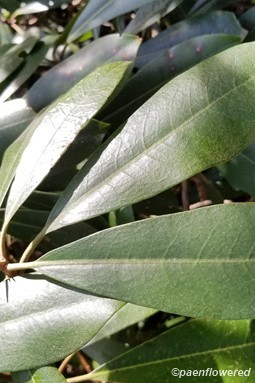
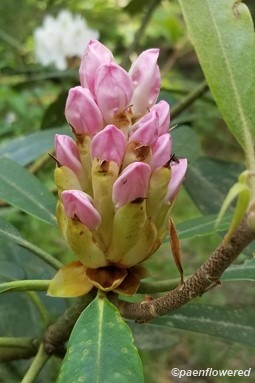
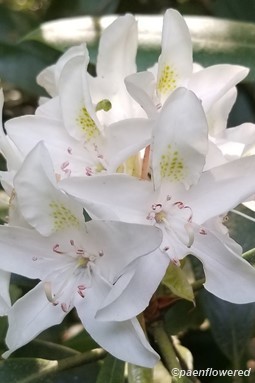
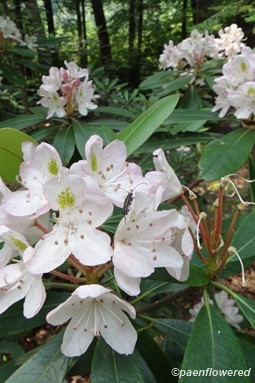
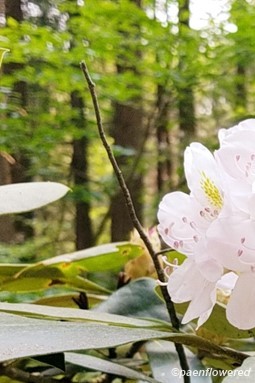
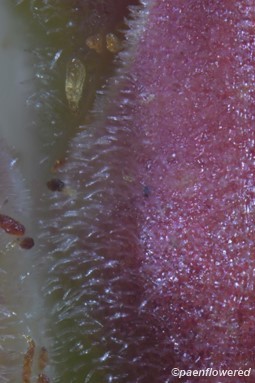

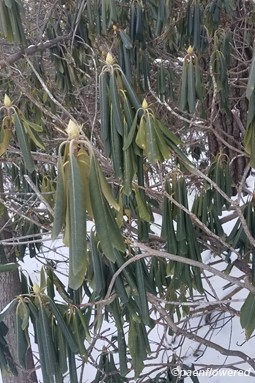






Comments
Have you spotted this plant in your area? We'd love to hear about your experience! Share your comments or questions about the plant below. Comments are moderated before posting.